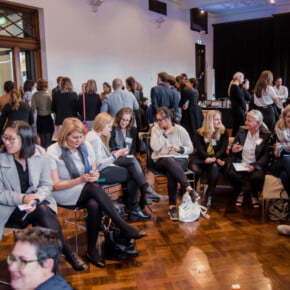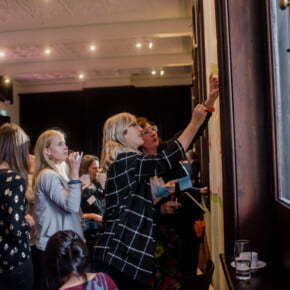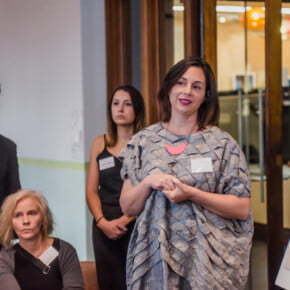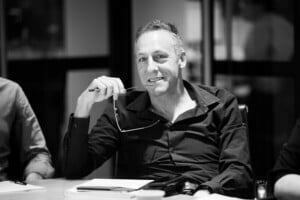Monica Edwards and Shaun Carter were instrumental in getting Architects Champions of Change going and remain highly involved. They discuss the Champions’ origins, achievements and challenges and plans for the future. This is followed by reflections from some of the Champions of experiences so far and next steps.
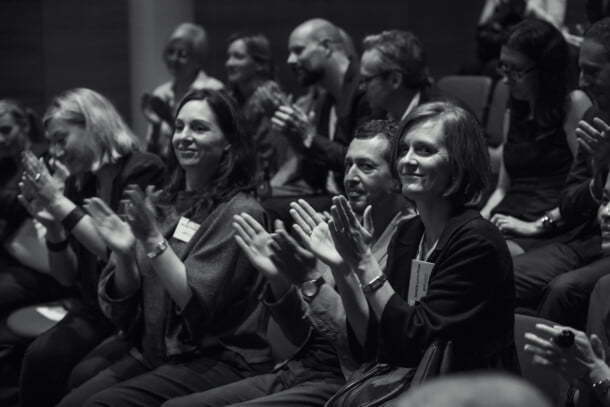
Monica Edwards, Joe Agius and Natalie Lane-Rose at the 2015 launch of the Architects Male Champions of Change. Photo: Oly Begg.
The Architects Champions of Change started out in New South Wales in 2015, with representatives from some of the country’s largest practices – Cox, Bates Smart, BVN, SJB, Hassell, Woods Bagot, Crone Architects and PTW. A second ‘national’ group formed in 2019, bringing Tzannes, Grimshaw, DKO, Hayball, Peddle Thorp, DesignInc and Nettleton Tribe to the table. The two combined this year, and the broader Male Champions of Change program became the Champions of Change Coalition.
How did the Architects Champions of Change get started? What are your first recollections?
MONICA EDWARDS: For me, it all began chatting to my sister in her local playground in 2012. We often spoke of our careers as we watched the kids play – we liked that. Although she’s in marketing and strategy, the challenges for women in the workplace are not dissimilar and we can learn from each other. That day I was telling her about this inspiring group I had joined, the newly formed NSW Gender Equity Taskforce (GET). At that stage, members were spending a month between meetings researching how we could position the group and what its focus should be. As we workshopped ideas, my sister insisted I meet her next-door neighbour, Janet Menzies. She and Janet were close, supporting each other as they negotiated the pressures of a working life with family life. Janet was the then Secretariat for Elizabeth Broderick’s Male Champions of Change, a program that targeted male leadership to advocate and act on gender equity in their own business. Through this connection, a personal connection of women supporting each other, doors were opened. Architecture had immediate access to the Champions of Change network.
At the next GET meeting, Natalie Lane-Rose also tabled the Champions of Change as a viable top-down approach, reasoning that we should avoid reinventing the wheel and work with adjacent programs that proved to be successful in bringing about change. It would take a year or so for Callantha Brigham and Shaun Carter to finally pull it off with the Institute but I do love that the genesis for this advocacy started with an innocent chinwag in the park. Advocacy can happen anywhere.
The other part of the story is GET itself. Equity advocacy groups can move in a few directions. One format is a “this has happened to me” support session. These are important as they help individuals navigate unfairness, but they often have little influence over changing it. Another format is the “group learning session”, composed of individuals with limited prior knowledge but motivated to see change. As they learn together, they can be overwhelmed by the complexity of inequity, leading to a lack of orientation. The most effective format is the “action group”. The NSW Gender Equity Taskforce (GET) was (and still is) one of these.
In 2012 GET was led by Callantha and Shaun, and populated by a diverse group of practitioners. All personality types were represented; there was a healthy gender mix; and a healthy stage-of-career mix with business owners, business managers and employees. We had academics and individuals who worked in government and client sectors. Finally, it included individuals working on a variety of employment contracts, from casual, to full time work to part-time to a fully flexible working life. Another critical component was GET’s collective research on gender equity – both in terms of individual experience and time dedicated to becoming informed. With this knowledge in hand, we knew that we could not resolve everything, but we could attempt to resolve something. We targeted a top-down, bottom-up approach wanting to affect leadership alongside empowering women at critical moments in their career.
SHAUN CARTER: The first I remember of the Champions was a vibrant GET meeting early one morning at Bourke Street Bakery in Darlinghurst. You [Monica], Natalie, Tarsha Finney, Maryam Gusheh, David Tickle and, of course, GET founder and chair, Callantha. To this day, GET is easily the best committee I have ever been involved with at the Institute. What a group! So bright, so fearless, so engaged – we felt like we were changing the world, and we were.
I think you and Nat were discussing Elizabeth Broderick’s Male Champions of Change program. GET was about actions not words – no longer would we, could we, stand by and listen to another tragic story about how gender inequality and indifference decimated another woman’s dreams and ambitions (I had no more tears to cry). There was such a clear logic to it. It was clever – get the men to pull their collective fingers out, and step up beside women to make change happen. It was that sort of clarity that stops you in your tracks. From that moment on, it became a foundation of what we were trying to achieve with GET – real Action.
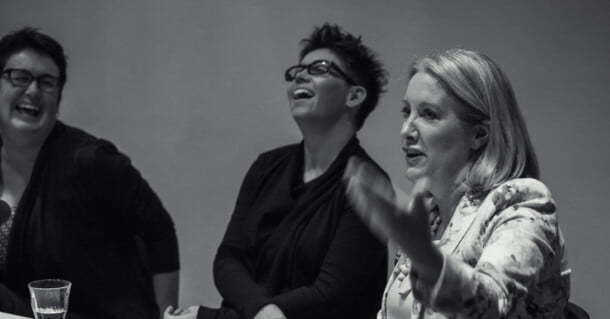
Elizabeth Broderick on a panel with Justine Clark and Naomi Stead at the launch of the Architects Champions of Change in 2015. Photo Oly Begg.
What was your motivation for getting involved?
MONICA: That one’s simple – a direct line to power.
As an advocate, you can sit on the sidelines for years agitating for change, but unless people see the need for change – understand it – it will never happen. The Champion’s program offered simple tools to support those in leadership positions to see the gendered work lives of their practice; to understand the limitations these had on women; and, through the simple act of listening, to motivate them to use their leadership to bring about change. Our leaders are good people. They do not mean to reinforce structures that make working harder for some and easier for others. Once they understood this, I knew they would change it.
I was also drawn to the four guiding principles of the Champions of Change. I still am. They have proved to be enduring:
- Men stepping up beside women
- Prioritise achieving progress on gender equality
- Stand behind our numbers
- Shift the system, not ‘fix women’
SHAUN: Callantha and I had become friends working on the Editorial Committee for the Architecture Bulletin. She had been telling me about the desperate need for the Institute to do something for the women of Architecture. She invited me to a Parlour event – Transform: Altering the Future of Architecture. It was a full house – 200 people – and I was one of the very few men.
The statistics were shocking. But what really cut me to the quick, was the mid-event workshop as the part of developing the Parlour Guides. To hear woman after woman tell their stories of dreams crushed was heartbreaking. I cried. It was very traumatic but very powerful.
After that Callantha asked me what I felt, what I saw. She said she’d been to countless events like these – hearing the devastating stories – and now she wanted to do something. Not to talk any more, but to form a group that was all about action; action that would set about change. She already had the idea of GET, and we planned how to make it happen.
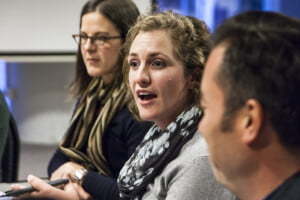
Callantha Brigham speaks at a workshop discussion at Transform: Altering the Future of the Profession, 2013. Photo: Jonathan Butler.
What needed to be done to get it up and running?
MONICA: Callantha and Shaun were responsible for manoeuvring through the NSW Chapter Institute of Architects’ approval processes. This was tricky and took time to resolve. Within GET, we understood that a few things would need to be in place to give an Architects Champions of Change the best starting position. We needed a sustainable, cost-free model that would not draw down on Institute resources. As such, each practice had to make a financial contribution to be part of the team. We understood that gender inequity was most pronounced in large practice, evident by the lack of women in senior leadership positions. Large practice also had the resources available to invest time and research, so we decided to target this scale. We needed the group to be composed of individuals perceived as leaders in the profession – both in terms of design and personal influence. Finally, the Champions of Change insisted that each Champion had to embrace a progressive outlook; it was essential that they were self-reflective individuals who welcomed change.
We were challenged by the proposition of a male-only group – who wouldn’t be? As we read more on the Male Champions of Change approach, we became convinced that creating a space for men to learn to be effective advocates was important. They would make mistakes; they would stumble; they would be confronted by their unconscious bias – but perhaps, with a male-only crew, they would not feel persecuted. As they have matured in their understanding of the structures and bias that limits equity, recognising that it is not linked to their gender but is a bigger cultural issue, the male-only criteria is less important, even limiting. I believe that the introduction of women as Champions in 2021 will further accelerate their understanding, this time less influenced by guilt or shame, and only motivated by hope.
SHAUN: Joe Agius was the NSW President at the time. A good man (and future Champion with Cox), and someone we trusted. Callantha and I invited Joe to a dinner. It was a rollicking affair – Callantha and I presented the idea and Joe jumped at it. He was immediately on board – the action of a champion – and he gave us the backing of the Institute to form GET.
Like all great movements, everyone and everything fell into place. Monica, Maryam, Tarsha, David, Natalie, Callantha and me; an energetic, bright, fearless and powerful group.
Soon after, I ran for the NSW Presidency with gender equity as one of three key planks of my agenda. It helped keep GET at the forefront of the Institute’s thinking and doing.
The MCC was one of our first actions. But it took a while to get up. We had to develop a new model of funding for the Institute – all from external sources. To this day I still think it is a template for a sustainable Institute. It also made us relatively independent.
Two key moments helped get the MCC up: Dr Jess Murphy agreeing to be our convener; and the enthusiastic response from the CEOs, Directors and business owners of the big practices of Sydney, who all embraced Champions of Change. We had momentum, and it felt unstoppable.
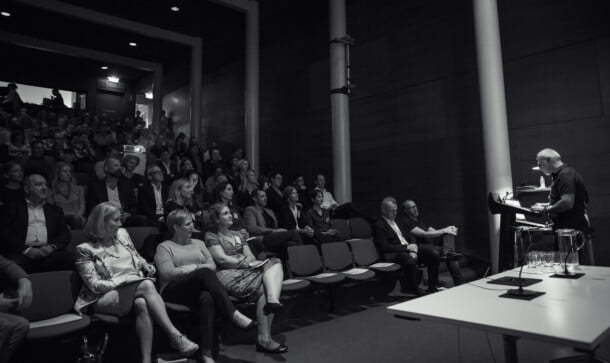
Shaun Carter speaks at the 2015 launch of the Champions of Change. Elizabeth Broderick, Jess Murphy and Callantha Brigham are seen in the front row. Photo: Oly Begg.
How has it developed over time?
MONICA: The Architects Champions of Change has gone through two cycles of the change process. This starts with Listening and Learning sessions, which are workshops where Champions listen to their teams to understand the gendered landscape of their business. This information is collected and filtered into Focus Areas for Action. Each Champion is assigned a Focus Group and together with their Implementation Leaders, develop actions to build incremental change through advocacy, leadership, policy and cultural transformation. These actions are then reviewed and measured over time.
There have been many changes in Champion representation over these two cycles. The group started with 10 Champions in 2015, which was reduced to 9 by 2016. The start of the second cycle in 2019 saw 16 Champions over two groups – the existing NSW Group and a new cohort, the National Group. Now we are at the start of the third cycle occupying a post-COVID world, where we have all lived the “great flex experiment”. Today, the Champions are a single group of advocates who meet regularly, composed of male and female leaders from NSW, Victoria and Queensland. As most practices are partnership structures, individual Champions have changed over time. We have had 26 Champions in total with three 2015 Champions remaining.
SHAUN: “Champs” has matured and grown over time. The unification of both groups this year is a big step in the right direction, in my opinion, and a clear sign of the CoC maturing.
It now feels like we have the size and weight of many big practices within architecture that we need to effect change – and the great work they have done with implementing policies that make a fundamental difference to redressing gender imbalance in our profession.
The other big step was to become a standalone initiative, separate from the Institute. Again, a sign of a process that is maturing. This gives us the ability to more freely make choices about how the CoC interacts with the profession and other professional groups, while still having a link to the Institute. It’s important if we want to grow our influence.
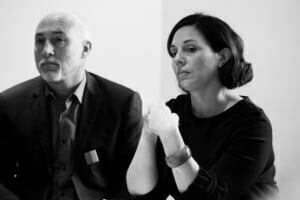
What is your ongoing role?
MONICA: I have been an Implementation Leader since 2015, coordinating action groups, editing publications, writing policy and helping to drive momentum. I participate in speaking panels, including those in other industries; delivered lectures at university; and written a handful of articles in architectural publications. Since 2019, Karen Le Provost and I joined the Champion meetings as representatives of the Implementation Leaders. In 2021, my role evolved to Special Advisor, acknowledging my work with GET, the Implementation Leaders and as a voice for employees.
SHAUN: I started in a ‘chair’ role. This has morphed into a Champions of Change role, which I prefer. Being the director of a small-medium practice within a group of large practice directors has been interesting. Seeing how these policies work at a smaller scale is important in understanding the broader effect of what we can do. What we do is easily scalable.
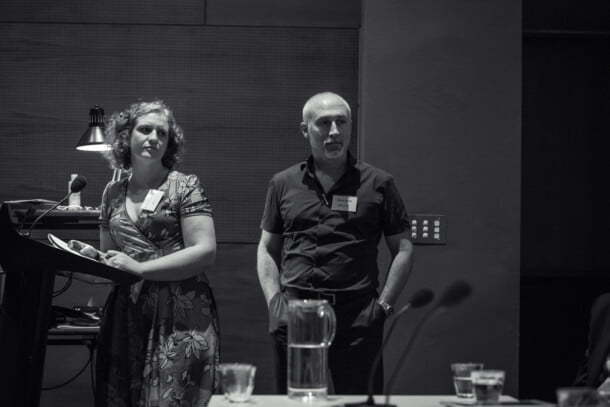
Callantha Brigham and Shaun Carter at the 2015 launch. Photo: Oly Begg.
What are the successes so far?
MONICA: Without question, All Roles Flex and equal parental leave policies. All Roles Flex sees flexibility offered to all employees regardless of gender or life needs. This saw a significant shift from flexibility being seen as a “female issue” to being understood as a workplace and culture issue. Parental leave policies have also been reviewed across the NSW Champion practices and will soon be reviewed in the National Group. Many have aimed for best practice, seeing the same benefits applied to new parents regardless of gender. Some have also addressed continuous super to individuals on extended career breaks to limit the accumulative difference at end of career.
The other success is that the Champions themselves have changed. This is best exemplified by Gary Powers, who was the Champion for Woods Bagot until a career change around 2017. One of the drivers of this decision was to better model equity – both in practice and on the home front, expressing a strong desire to be present in family life with his wife and five children. Gary continued to advocate for diversity post-Champions, endlessly questioning and challenging new forms of leadership and unconscious bias within his network.
SHAUN: Our successes so far have been :
- the policy work and implementation;
- the personal growth of the champions;
- ditching the ‘male’ tag of the movement (it felt like it was becoming a weight we didn’t need and holding us back);
- the rise and recognition of our Implementation Leaders as equals in the process, and having them always at the table;
- the growing of the Architects CoC;
- bringing Justine Clark into the CoC as special advisor; and
- our mighty leader, Dr Jess Murphy.
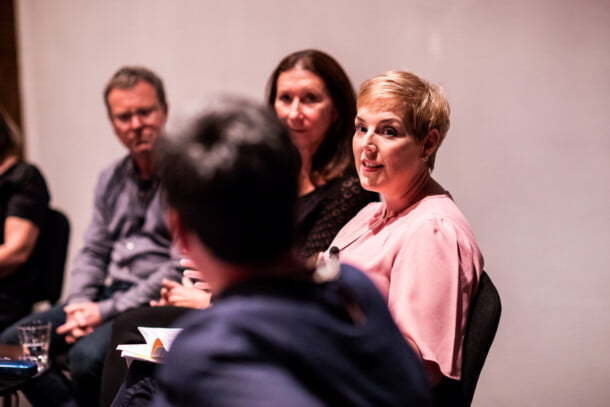
Jess Murphy, convenor of Champions of Change at Data at Work, 2018, with Andrew Nimmo and Leone Lorrimer. Photo: Boaz Nothman.
What are the challenges or limitations of the program?
MONICA: The unconscious bias of Champions and their partners in practice. Unconscious bias is the unintended thought patterns and actions that reinforce unfairness, making it harder for some and easier for others. We all have unconscious bias. We all have blinkers. We are all imperfect. Acknowledging the existence of these blind spots and being prepared to improve on them is critical for change. I’d like to see the other practice partners participate in workshops to understand patterns and behaviours that reinforce gendered bias. In this process, a Champion will take two steps forward and one step back as they negotiate progress with their leadership team. Addressing unconscious bias practice-wide – particularly at leadership levels – is critical if we are to move beyond this point.
Tiredness is also a challenge. The scale of this change is a long haul and I’ve noticed enthusiasm for the Champion process goes through a pattern of peaks and troughs. It’s hard to be consistently motivated. We’ve learnt that light touch points are as equally effective as big, structural overhauls, so this year we’ve adjusted Champion reporting slightly. Each Champion is to demonstrate regular changes in their business and professional advocacy quarterly. This aims to build momentum for equity to be front of mind in business operations and professional leadership throughout the year. Nothing like a deadline to get things moving!
SHAUN: For me, our immediate challenge is communicating our successes, processes and agenda. It is fundamentally important the profession knows what we are doing and how we feel we are changing the profession. It is especially important that women know what we are doing. Gender Equality needs to permeate into every corner, every nook and cranny of the profession for effective change to happen. Communication is a key tool in achieving that task.
Another challenge or limitation could be taking on a greater advocacy role in calling out poor behaviour and performance both within the profession and without. This is something we have recently grappled with and an area we should continue to work on.
Ultimately our biggest challenge though, and the aspect of what we are trying to do that may be our biggest limitation, is real change. If we don’t seriously effect change in a 10-year period it will break my heart, and the hearts of so many of the women in our profession too. The fear of failure should also keep us sharp and focused.
Participate, a collaboration between the NSW GET and Parlour, 2017.
What has surprised you?
MONICA
- The kindness of Champions;
- The influence of women Champions;
- The influence of the Champion Coalition on the Australian population – it affects 1.5 million employees globally; the Australian workforce is 12.9 million. These numbers are staggering.
- The persistence of unconscious bias.
SHAUN: So much. The longevity, the momentum, the evolution, the willingness, growth, and the real change I believe we are helping to create. On a personal level, personal growth – especially around unconscious bias and language.
What needs to be done in the future?
MONICA: My goodness, there’s always so much to do.
- I am currently interested in moving beyond the binary comparison of men and women to understand the diversity of gender within individuals. Essentially, looking at individuals as exactly that – individuals.
- Age is a barrier in our profession. Let’s keep working opportunities open to all, particularly considering the cumulative effect of a lack of savings due to career breaks and lower pay for women in our profession.
- Unless you receive a reasonable income, it’s a struggle to be a single working parent. Let’s adjust our structures to keep them in rather than keep them out.
- The constant: promoting diversity in leadership. Our leadership looks similar to that of five years ago. Many practices have a new tier of leadership, but I am interested in understanding the representation of equity owners.
- Often those swimming in the fast stream of unconscious bias, the people that receive the benefit, feel a sense of loss as focus is readjusted. I want to harness this sense of loss and turn it into something positive – I know that we can all rise together.
- I want business to invest in checks and balances with policy and procedures. Isolating the drafting of these policies to a single individual invites unconscious bias. We need to take advantage of our teams and utilise the lens they read policy with.
- Leadership sets the tone. Encourage all leaders to work towards a transparent leadership that supports their team to be their best.
- Career pathways are tricky… we’ve focused on this for six years now and I don’t feel we have a meaningful strategy. There are unwritten rules that clearly shape gendered barriers. Once we see them, we shall act on them.
- Improve on our measurements of the gender pay gap and seek to reduce this.
- Gender is a single lens. what are the intersections that influence our unconscious bias – personality, race, socio-economic, religion, even our schooling?
- Can we use gender to support important issues such as Designing with Country and progressing Aboriginal and Torres Strait Islander representation?
This is a long list. If I am being direct, my single focus is improving representation in leadership. It always has been. I am not interested in revealing other forms of leadership. As far as I’m concerned, this is a cover-up. I am interested in tackling the dominant issue – that the leadership structures in our profession are populated by a leadership group that looks the same. Addressing anything less would be a compromise.
SHAUN: We need to lift our communication to the broader profession – to reach out to the edge of our field, and affect them in a meaningful way.
What might success look like after 10 years?
MONICA: That’s four years away, so I need to be realistic. I wish I could say that we see people as individuals, working with them not against them to help them thrive, but I’m not convinced that this is a realistic goal. In the next four years, I think we can achieve measuring and publicly reporting on the gender pay gap. Let’s go for that. If we report publicly, we will improve it publicly. Across most of the practices, the gender pay gap tracks ok pre-business ownership. However, significant disparity is revealed at the business ownership level. If we are committed to closing the gap, by default we will see more women in business ownership by the end of the decade. So let’s start measuring – small steps lead to big gains. And for everyone else in the profession, why not measure the gender pay gap in your practice too. And publish it on Parlour! I’m all for transparency!
SHAUN: For me, success will be seen in our results. Our constant measuring should show real and lasting improvement – not in the margins either, but substantial percentage changes of greater than 10 to 20%.
What does this mean in practice? A significant lift in female CEOs, Directors, Associates and team leaders. With women equally represented in the power positions of our profession, we will help change happen faster and cement change permanently.
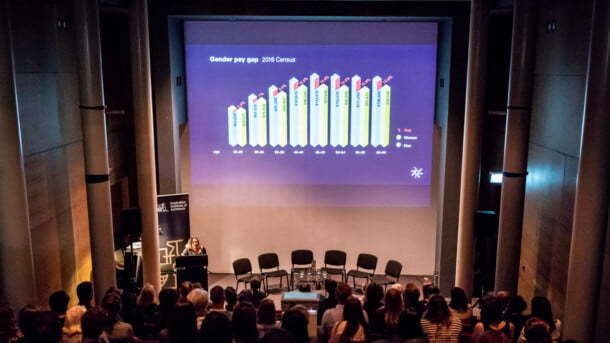
Gill Matthewson discusses the pay gap at Data at Work, an event held as collaboration between Parlour and the Champions of Change. Photo: Boaz Nothman.
What would you say to a practice considering getting involved?
MONICA: Start today. You don’t need to be a Champion to engage with the Champion process.
- Listen to your team to understand gendered issues in your practice.
- Commit to actions that respond to what you heard; measure these.
- Encourage all leaders in your practice to do the Leadership Shadow.
- Introduce All Roles Flex and Parental Leave policies that are blind to gender.
- Become aware of your own unconscious bias; encourage your team to do the same.
- Be informed – don’t wait to be told, read and learn about equity.
- And when you witness unfairness, speak up.
And call me – any time. I mean this started with a chat….
SHAUN: Do it – and as fast as you can.
I would say the same thing today as I did when we first started Architects Champions of Change – it will be the best business decision you’ll ever make. For me there are ethical and moral imperatives why I think all practices should be involved, but however you come to the realisation that we all need to make our professional gender equal as a fundamental necessity – you’ll never regret the decision and it will be the best investment you can ever make.
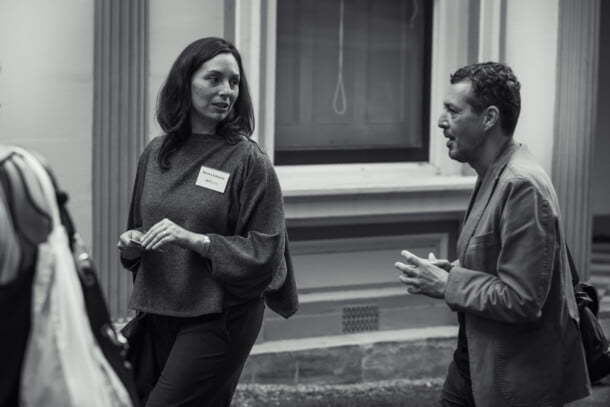
Monica Edwards and Joe Agius at the 2015 launch. Photo: Oly Begg.
So, what has Champions of Change meant for those involved? Nine Champions reflect on experiences so far and next steps.
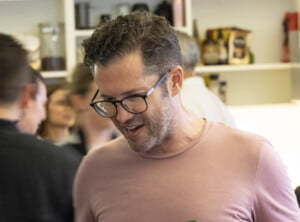
The MCC process has allowed us to better understand the detailed implications of equity – for me as an individual and for our practice.
The culture of collaboration and shared learning between the practices involved has allowed us to develop strategies and tools to make genuine change to the broader profession. We look forward to the next stage of implementing change and understanding the effectiveness of these tools.
– Ben Green, Tzannes
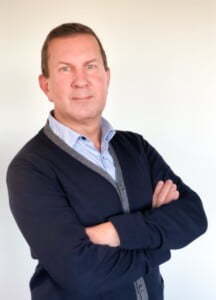
It’s a challenge to put yourself into the shoes of others; to understand the personal impact that being treated differently has on your sense of self. Hearing others tell their previously undisclosed stories, often subtle but in totality having personal impact, has been enlightening.
It’s taking too long to eliminate discrimination. We need to step up as a community, and as a profession, and importantly as individuals to take responsibility for our actions. Through persistent, pro-active action we can make a difference.
I’ve learnt about my own attitudes, unconscious bias and behaviour. With the help of others in the Champions of Change Coalition, I know I can make a positive contribution to meaningful change and ensure a cultural shift that can be sustained and unchallenged.
– Brett Hudson, Peddle Thorp

I am honoured to represent Woods Bagot in the Architects Champions of Change Coalition, along with other Champions and Implementation Leaders. I continue my commitment to be a part of this important movement in the pursuit of the basic human right for women to be treated as equals and have the same opportunities and representation as men for the betterment of society.
I have learnt that while the problem we face can sometimes feel overwhelming, if we break down the issues into smaller actions and focus the core sources, then the sum of the parts starts to address the larger systemic problems. I have learnt the importance of measuring data at a granular level, putting systems in place to have the data available when making daily and key decisions, particularly as a group. The data combined with unconscious bias training equips individuals with the ability to initiate tough conversations rather than acceptance of business as usual. The sharing of knowledge has taught me to be more attuned to the issues and the training has empowered me, giving agency and responsibility, knowing that I can and should make a difference.
I now have the confidence to lean into those moments where women are overlooked, dismissed, and treated poorly and unfairly. I have learnt things about myself and my personality that I need to challenge and get out of my comfort zone if I’m going to make a difference and be an up-stander vs a by-stander. And when we feel overwhelmed or down, there is community of support around us who will step-up beside us and help.
– John Prentice, Woods Bagot
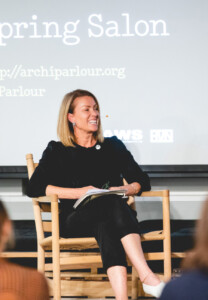
Despite BVN being involved in (Male) Champions of Change since the beginning, I am relatively new to the group just starting this year. The dropping of the ‘male’ meant Brian Clohessy could pass the batten to me, which is a logical step. We need more women represented.
I’m just getting to know everyone, but it seems like a good bunch. So far the aspect I am really appreciating is gaining better understanding of how my male peers are thinking, feeling and doing things. Building better understanding can only help us shift things. It also gives me fuller insight into where we are at as an industry. Hopefully having me in the group helps also! I think we need to acknowledge that we are mostly private companies and change is in our hands today. I hope we can get some traction and give everyone the confidence to move further forward starting today… not tomorrow.
– Ninotschka Titchkosky, BVN
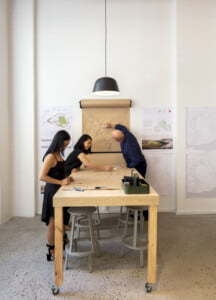
It saddens me that our industry doesn’t achieve gender equity. It feels like a problem that should have been addressed a long time ago. I thought we’d be better.
I spoke to my mum the other day – she tells a story of how when she interviewed as a legal secretary for the Police (albeit a different country, a different time) they made her show her legs in the interview. Despite the time that has gone by I was shocked to hear this, but even worse is that the stories seem to keep coming.
Reflecting on working with the Champions of Change, it’s been empowering to work with so many committed people who have come together to help change this. Every step we have taken together has seen incremental improvement, but there is much more to do and I’m proud to be a part of it.
– Dave Tordoff, Hayball
Our practice culture is anchored by our key values and ethos; we aim to create a safe, inclusive and diverse space in which our people can thrive. Our commitment to Champions of Change and the listening, learning and sharing of ideas and stories from both within our practice and alongside our peers has been invaluable. For us stories carry culture, they matter – we know that ours is a work in progress. There is no ‘full stop’ on making positive, meaningful change.– Dave Randerson, DKO
I am very happy to accept the baton from Joe Agius and to continue with the great work of the past Champions! We have many good stories of change to tell – one of my favourites is that our newest Director was appointed while on parental leave into a caring system that did not exist before. She returns to lead the office’s largest and tallest project, working alongside the client that herself has returned from a recent birth. I see that our leadership overwhelmingly believes that encouraging diversity and balance leads to better design outcomes and more exciting studio environments. Part of our challenge going forward is to take the agenda of Architects CoC away from a Sydney Melbourne initiative and ensure the values and agenda are shared nationally. I see that we still have work to do, we must continue to disrupt the system, providing a proactive, preventative safe work environment that reflects our values in environment and cultural diversity.
– Ian Sutter, Cox
Being part of the Champions of Change Group has been a journey of increasing awareness of gender inequality and the challenges of changing cultural stereotypes, associated with a personal journey of self-discovery. Men and women do not start at a level playing field. To improve on gender equity, we have sought to understand the cultural norms and systemic biases that inhibit it and will advocate for improvements in the architectural and construction industry, publicly and behind closed doors, while continuing to influence best practice change within Bates Smart.
–Philip Vivian, Bates Smart
Champions of Change has given me the opportunity to take time to critically look at both my personal actions and the collective actions of the studio.
You don’t start the day wondering how to make someone’s life miserable or difficult, but that happens if you’re not conscious of your own gender or cultural bias. A flippant comment, or an insensitive approach can be completely disempowering. Taking time to listen, consider, reflect and learn is critical if we are to achieve a more just and supportive culture. As a gay man I have a lived experience of discrimination and bias – my ambition is to contribute to building a society that gives as many rights and opportunities to my niece as it does for my nephew. Your gender shouldn’t define you.
– Adam Haddow, SJB







